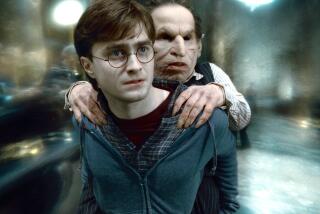Harry Potter echoes in new books by Rainbow Rowell and Patrick Ness
- Share via
We live in a post-”Star Trek” world, a post-”Star Wars” world, a post-”The Lord of the Rings” world, with these tales echoing throughout our current pop culture climate. It was only a matter of time before “Harry Potter” joined that category.
So what does a post-”Harry Potter” story look like? It explores a magical world with its own rules and rulers that exist adjacent to our world. So many of our stories come from the rehashing or remixing of others, to the point that even if the aforementioned tales are not the first of their kind, they’re notable because they are some of the best-known versions of their kind around the world.
Two new YA novels — “Carry On” by Rainbow Rowell and “The Rest of Us Just Live Here” by Patrick Ness — each rely on the audience’s knowledge of these types of stories and share DNA with the Harry Potter series, adding a postmodern twist to the familiar tropes.
“Carry On” was inspired by Rowell’s own 2013 YA novel “Fangirl,” in which the main character writes fan fiction about a “Harry Potter”-type series called “Simon Snow.” (Rowell explains in an author’s note here that while one might recognize familiar elements from “Fangirl,” “Carry On” is neither a book from that imaginary series nor the main character’s fan fiction, but a different story altogether.)
At the center of “Carry On” is the magical school of Watford in Britain. The parallels to Potter are clear: The prophesied “chosen one” Simon Snow has a rich nemesis, Bas, reminiscent of Draco Malfoy; a good, clever friend who comes off like the child of Ron and Hermione; an enigmatic, professor Dumbledore-esque mentor; and an enemy (the Insidious Humdrum) he’s destined to defeat. But it’s not as cut and dried as all that — instead, the characters have a fresh perspective on their Harry Potter-esque magical world, explaining things left unsaid in the Harry Potter novels, commenting on what works and what doesn’t, and describing how the current world came to be.
As in Rowell’s previous novels, the prose is clear and succinct, and at the heart of the story is a solid mystery — who paid to have Bas’ mother killed all those years ago? — which recalls historical plots in Harry Potter books, like the Marauders in “The Prisoner of Azkaban,” or Voldemort’s Horcruxes in “The Half-Blood Prince.”
Patrick Ness knows something about playing with classic science fiction and fantasy: He has just signed on to write a “Doctor Who” spinoff TV series called “Class.” His new YA novel has its share of post-Potter genre tropes. “The Rest of Us Just Live Here” is set in a world where apocalypses happen every generation, and a specific group of teens — “the indie kids” — are charged with fixing it.
The main characters of his delightful novel, however, are those on the outside of the action, more preoccupied instead with their own personal struggles (love, friendship, family), only wishing to survive these strange goings-on rather than be heroic. As one boy explains, “[E]ven if there’s no one in my family or my circle of friends who’s going to be the Chosen One or the Beacon of Peace or whatever … it’s going to be next time around, I reckon there are a lot more people like me than there are indie kids with unusual names and capital-D destinies.”
The most notable difference between the Rowell and Ness books and the original Potter series (other than the use of current technology, since these stories are set in 2015 instead of 1997) is the remarkable diversity of characters. When I first read the Harry Potter books, I remember being excited to see the Patil twins, the first girls of color I’d come across in the fantasy and science fiction I’d read or seen. But aside from minor figures like the Patils, the story is dominated by straight white characters — even Dumbledore was revealed to be gay only after his death.
“Carry On” and “The Rest of Us Just Live Here” boast multiple gay characters; in fact, the central characters question their sexuality in both books. Biracial characters and a diverse array of families are well-represented, and both novels extol the virtues of therapy, something the Potter books could’ve benefited from, considering the trauma most of the characters experience.
The Harry Potter books were permeated by J.K. Rowling’s own predilections and biases, for better or worse. But that legacy has taken on a life of its own, open to new angles and ideas. Both of these books challenge the tropes of the Potter series even as they take inspiration from it. This balance of tribute and judgment is a tough one to strike, but it works.
Misra is a freelance writer who lives in Los Angeles.
::
Carry On
Rainbow Rowell
St. Martin’s Griffin: 528 pp., $19.99
The Rest of Us Just Live Here
Patrick Ness
HarperTeen: 336 pp., $17.99
More to Read
Sign up for our Book Club newsletter
Get the latest news, events and more from the Los Angeles Times Book Club, and help us get L.A. reading and talking.
You may occasionally receive promotional content from the Los Angeles Times.









